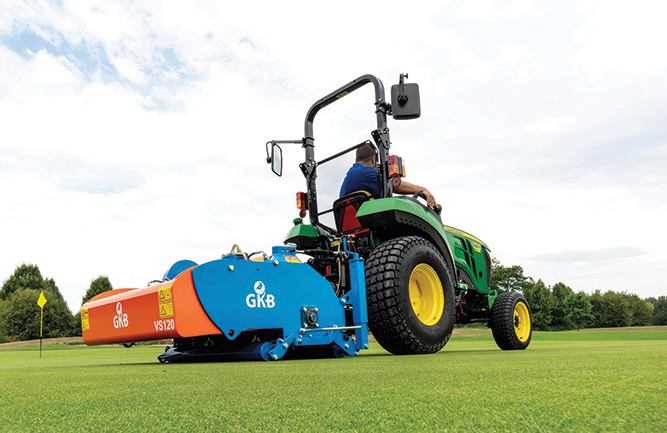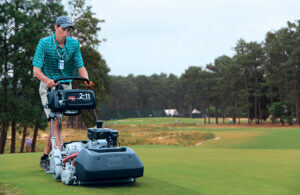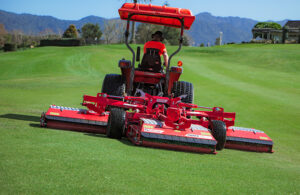Expert insights on controlling thatch on greens

Controlling thatch is an essential part of maintaining a healthy golf course putting green. But, at the same time, it can be a significant balancing act for superintendents and their crews. Too much thatch can be a death sentence for turf, but having some thatch accumulation can be beneficial.

James Murphy, Ph.D., director of the Rutgers Center for Turfgrass Science and an Extension specialist, says that at some point — it could be up to several years — the thatch layer gets thick enough that the grass root system grows in thatch, not in the soil.
While thatch can be soil-like, it’s not truly soil, so the nutrient and water uptake start to be affected.
“Those are the issues that thatch can cause agronomically,” he adds. “It becomes easier to stress (the turf) than if it were soil. Soil is more buffered, and the changes aren’t as extreme or rapid as they can be in thatch, so you’ll see bigger swings in the health and fitness of the turf when it’s growing in thatch.”
Finding the golden ratio of thatch on your putting greens isn’t easy and has been the focus of a lot of industry research. According to Murphy, for golf course greens, superintendents will want a thinner layer of thatch than you might want on your lawn at home.
“In the growing season, you’re using topdressing to try to modify that organic material as it develops to give it a more soil-like characteristic,” he says. “With too much thatch, there’s only so far that those sand grains will filtrate into that before everything starts bridging.”
There are several ways to get a look at how much thatch is on a putting green, including taking a soil profile. But the easiest way, Murphy says, is to take a walk on the green and get down in the dirt.
“Visual inspection is one of the keys,” he says. “You can feel it when you walk on it. You can put your fingertips onto the turf and feel the softness that’s developing. You don’t want to let it get too soft because that’s correlated to how thick that thatch layer is.”
Experts’ Insights

1st Products
Jacob Parrish // Regional Sales Representative
Thatch control is vital for healthy, high-performing fairways and greens. Superintendents can manage thatch through aeration, topdressing and proper mowing practices. Aeration alleviates compaction, while topdressing with sand improves drainage and reduces thatch buildup. Regular mowing at the correct height ensures that the grass stays healthy without excess organic matter accumulating.
Proper thatch control is key to maintaining healthy turf. Without it, excess thatch can hinder root growth, impair water infiltration and foster disease. By actively managing thatch, superintendents ensure that fairways and greens remain resilient, providing golfers with a superior playing experience. Our new VC-90, which features three independent cutting heads, is designed for efficient verticutting, especially on undulating terrain. This flexibility allows for fast, precise thatch removal.

STEC
Brandon Cox // Sales Manager
Controlling thatch on a golf course, and especially greens, is very important to their health, playability and golfer satisfaction. A fertilizer/amendment program is one of the ways to control thatch. The two most common practices for controlling thatch are core aeration and verticutting, both of which are often followed by topdressing the greens. Core aeration is going to have about a four-percent organic exchange on your greens.
Verticutting is another option, and while not as aggressive or needing as much downtime as aeration, it can provide great results as it removes thatch and also promotes new grass growth. Verticutting is often followed by topdressing as well to help fill in slits and help with changing your soil profile. STEC Equipment has aerators, verticutters and the Sandfiller to help you with all of these practices. The benefits and importance of thatch control are as follows: better drainage on your greens and, in turn, firmer greens, better path for nutrients to your root zone and, as this makes the grass healthier and stronger, increasing its ability to fight off invasive weeds and other types of grasses.

DryJect
John Paddock // Owner and President
The rate at which thatch accumulates in turf is highly influenced by the inputs of the superintendent. Careful attention should be given to only apply enough fertility and water to produce a uniform, healthy playing surface as excess inputs will magnify thatch accumulation. Thatch levels can be manipulated by encouraging healthy biological activity (decay) by incorporating the native soil back into the top portion of the thatch through core aeration and dragging.
Topdressing or injection with a blended soil/sand mix or with sand alone are other options superintendents should consider. By incorporating these materials, superintendents can create a “hybrid thatch” or mat, which firms it up and encourages robust microbial activity and decay. Regular incorporation of the desired soil medium will provide the necessary dilution to this organic matter. On sand-based putting greens or sports turf, the injected or topdressed sand should be close to matching the sand in the soil profile. By implementing these best practices, superintendents can effectively control thatch accumulation, improve soil health and maintain high-quality playing surfaces for golfers.

Redexim
Jeb Browder // National Sales Manager
There are multiple ways for superintendents to control thatch, including limiting nutrients and fertilizer to the plant to limit growth and excessive grass clippings that create thatch. The superintendents who take on a lot of golf may not be able to go this route as they will need the extra nutrients. Plant growth regulators (PGRs) for those that can apply will also limit excessive plant tissue growth. Always use baskets when mowing. Grooming and verticutting is another way to actively remove thatch. Using baskets while doing this practice is important but not always labor-friendly as the baskets tend to fill up quickly, requiring extra dumping. Topdressing is another great way to dilute thatch and organic matter. Aerification is a great way to mechanically remove thatch and organic matter by using coring tines. Solid tines could also be used to create voids to be filled with extra topdressing sand that would further dilute thatch.
Related Articles
Turf MD: Dr. D notices a new summer agronomic problem
Experts share why thatch control is critical to turfgrass health











